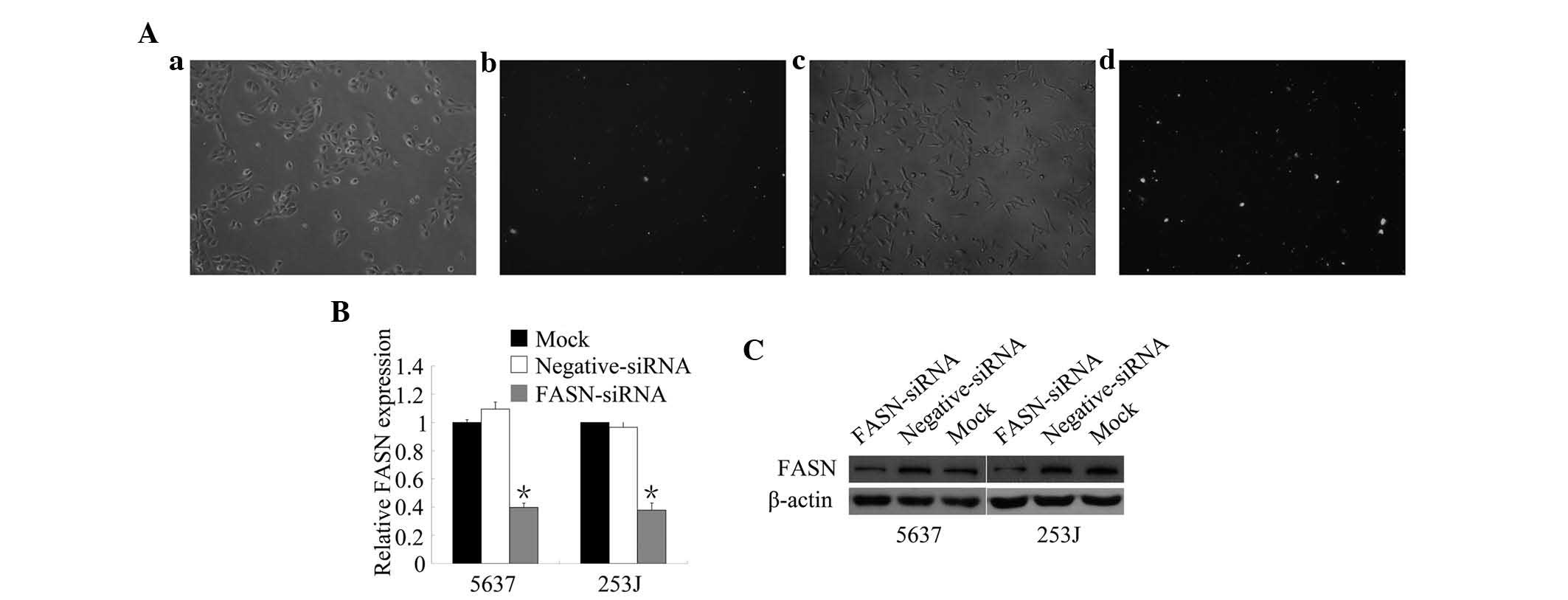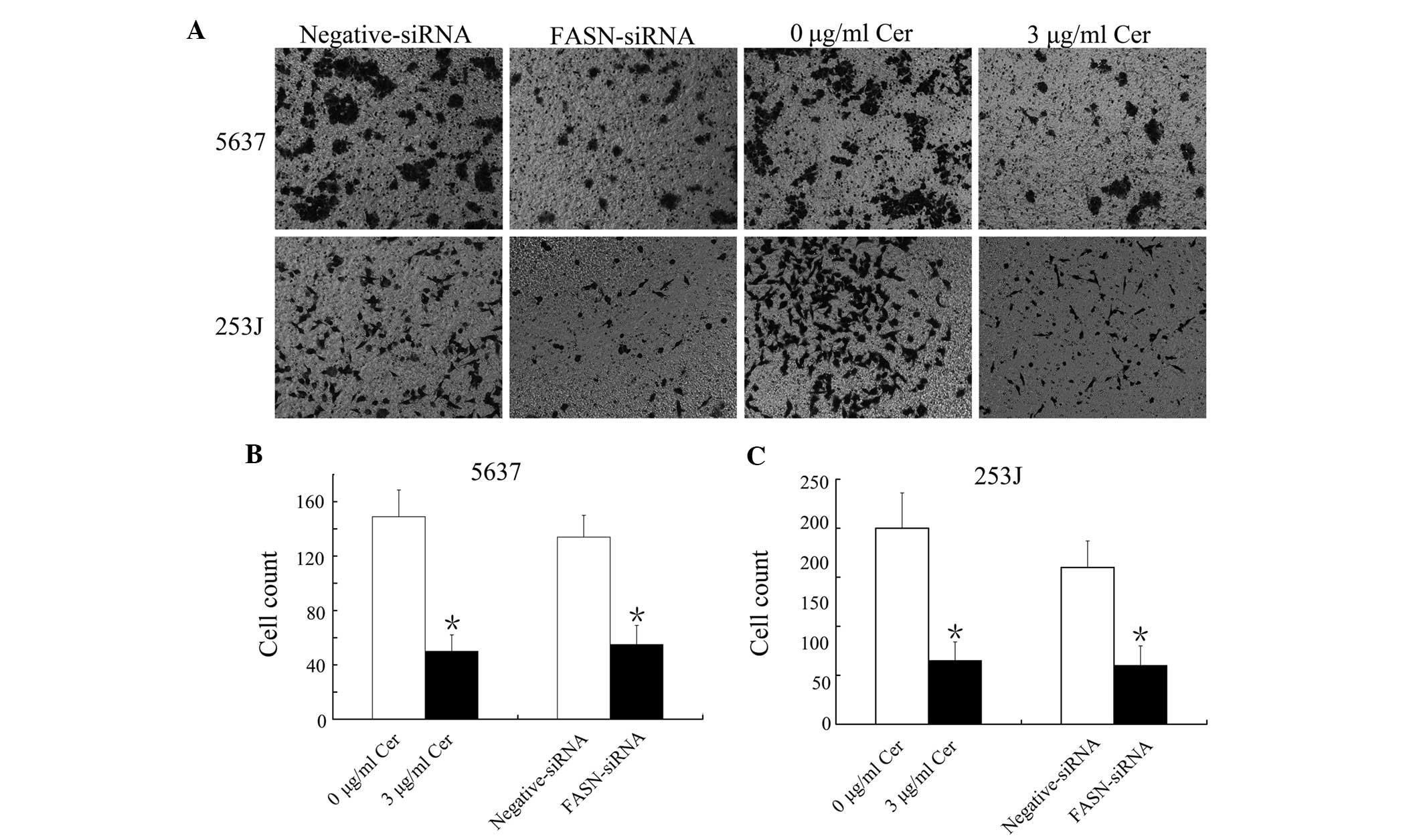|
1
|
Shariat SF, Karakiewicz PI, Palapattu GS,
Lotan Y, Rogers CG, Amiel GE, Vazina A, Gupta A, Bastian PJ,
Sagalowsky AI, et al: Outcomes of radical cystectomy for
transitional cell carcinoma of the bladder: A contemporary series
from the Bladder Cancer Research Consortium. J Urol. 176:2414–2422.
2006. View Article : Google Scholar : PubMed/NCBI
|
|
2
|
Madersbacher S, Hochreiter W, Burkhard F,
Thalmann GN, Danuser H, Markwalder R and Studer UE: Radical
cystectomy for bladder cancer today-a homogeneous series without
neoad-juvant therapy. J Clin Oncol. 21:690–696. 2003. View Article : Google Scholar : PubMed/NCBI
|
|
3
|
Philips GK, Halabi S, Sanford BL, Bajorin
D and Small EJ; Cancer and Leukemia Group B: A phase II trial of
cisplatin (C), gemcitabine (G) and gefitinib for advanced
urothelial tract carcinoma: Results of Cancer and Leukemia Group B
(CALGB) 90102. Ann Oncol. 20:1074–1079. 2009. View Article : Google Scholar : PubMed/NCBI
|
|
4
|
Wu M, Dickinson SI, Wang X and Zhang J:
Expression and function of SIRT6 in muscle invasive urothelial
carcinoma of the bladder. Int J Clin Exp Pathol. 7:6504–6513.
2014.PubMed/NCBI
|
|
5
|
Ferlay J, Soerjomataram I, Dikshit R, Eser
S, Mathers C, Rebelo M, Parkin DM, Forman D and Bray F: Cancer
incidence and mortality worldwide: Sources, methods and major
patterns in GLOBOCAN 2012. Int J Cancer. 136:E359–E386. 2015.
View Article : Google Scholar
|
|
6
|
Kuhajda FP, Jenner K, Wood FD, Hennigar
RA, Jacobs LB, Dick JD and Pasternack GR: Fatty acid synthesis: A
potential selective target for antineoplastic therapy. Proc Natl
Acad Sci USA. 91:6379–6383. 1994. View Article : Google Scholar : PubMed/NCBI
|
|
7
|
Wakil SJ: Fatty acid synthase, a
proficient multifunctional enzyme. Biochemistry. 28:4523–4530.
1989. View Article : Google Scholar : PubMed/NCBI
|
|
8
|
Kuhajda FP: Fatty acid synthase and
cancer: New application of an old pathway. Cancer Res.
66:5977–5980. 2006. View Article : Google Scholar : PubMed/NCBI
|
|
9
|
Orita H, Coulter J, Lemmon C, Tully E,
Vadlamudi A, Medghalchi SM, Kuhajda FP and Gabrielson E: Selective
inhibition of fatty acid synthase for lung cancer treatment. Clin
Cancer Res. 13:7139–7145. 2007.PubMed/NCBI
|
|
10
|
Abdel-Magid AF: Fatty acid synthase (FASN)
inhibitors as potential treatment for cancer, obesity, and liver
related disorders. ACS Med Chem Lett. 6:838–839. 2015. View Article : Google Scholar : PubMed/NCBI
|
|
11
|
Jiang B, Li EH, Lu YY, Jiang Q, Cui D,
Jing YF and Xia SJ: Inhibition of fatty-acid synthase suppresses
P-AKT and induces apoptosis in bladder cancer. Urology.
80:484.e9–e15. 2012. View Article : Google Scholar
|
|
12
|
Livak KJ and Schmittgen TD: Analysis of
relative gene expression data using real-time quantitative PCR and
the 2(-Delta Delta C(T)) method. Methods. 25:402–408. 2001.
View Article : Google Scholar
|
|
13
|
Saeb-Parsy K, Veerakumarasivam A, Wallard
MJ, Thorne N, Kawano Y, Murphy G, Neal DE, Mills IG and Kelly JD:
MT1-MMP regulates urothelial cell invasion via transcriptional
regulation of Dickkopf-3. Br J Cancer. 99:663–669. 2008. View Article : Google Scholar : PubMed/NCBI
|
|
14
|
Di Carlo A, Terracciano D, Mariano A and
Macchia V: Urinary gelatinase activities (matrix metalloproteinases
2 and 9) in human bladder tumors. Oncol Rep. 15:1321–1326.
2006.PubMed/NCBI
|
|
15
|
Houédé N and Pourquier P: Targeting the
genetic alterations of the PI3K-AKT-mTOR pathway: Its potential use
in the treatment of bladder cancers. Pharmacol Ther. 145:1–18.
2015. View Article : Google Scholar
|
|
16
|
Chen M, Gu J, Delclos GL, Killary AM, Fan
Z, Hildebrandt MA, Chamberlain RM, Grossman HB, Dinney CP and Wu X:
Genetic variations of the PI3K-AKT-mTOR pathway and clinical
outcome in muscle invasive and metastatic bladder cancer patients.
Carcinogenesis. 31:1387–1391. 2010. View Article : Google Scholar : PubMed/NCBI
|
|
17
|
Cheng G, Palanisamy AP, Evans ZP, Sutter
AG, Jin L, Singh I, May H, Schmidt MG and Chavin KD: Cerulenin
blockade of fatty acid synthase reverses hepatic steatosis in ob/ob
mice. PLoS One. 8:e759802013. View Article : Google Scholar : PubMed/NCBI
|
|
18
|
Nomura S, Horiuchi T, Hata T and Omura S:
Inhibition of sterol and fatty acid biosyntheses by cerulenin in
cell-free systems of yeast. J Antibiot (Tokyo). 25:365–368. 1972.
View Article : Google Scholar
|
|
19
|
Valencia-Sanchez MA, Liu J, Hannon GJ and
Parker R: Control of translation and mRNA degradation by miRNAs and
siRNAs. Genes Dev. 20:515–524. 2006. View Article : Google Scholar : PubMed/NCBI
|
|
20
|
Bessadóttir M, Skúladóttir EÁ, Gowan S,
Eccles S, Ögmundsdóttir S and Ogmundsdóttir HM: Effects of
anti-prolif-erative lichen metabolite, protolichesterinic acid on
fatty acid synthase, cell signalling and drug response in breast
cancer cells. Phytomedicine. 21:1717–1724. 2014. View Article : Google Scholar
|
|
21
|
Sadowski MC, Pouwer RH, Gunter JH, Lubik
AA, Quinn RJ and Nelson CC: The fatty acid synthase inhibitor
triclosan: Repurposing an anti-microbial agent for targeting
prostate cancer. Oncotarget. 5:9362–9381. 2014. View Article : Google Scholar : PubMed/NCBI
|
|
22
|
Veigel D, Wagner R, Stübiger G, Wuczkowski
M, Filipits M, Horvat R, Benhamú B, López-Rodríguez ML, Leisser A,
Valent P, et al: Fatty acid synthase is a metabolic marker of cell
proliferation rather than malignancy in ovarian cancer and its
precursor cells. Int J Cancer. 136:2078–2090. 2015. View Article : Google Scholar
|
|
23
|
Jin X, Zhang KJ, Guo X, Myers R, Ye Z,
Zhang ZP, Li XF, Yang HS and Xing JL: Fatty acid synthesis pathway
genetic variants and clinical outcome of non-small cell lung cancer
patients after surgery. Asian Pac J Cancer Prev. 15:7097–7103.
2014. View Article : Google Scholar : PubMed/NCBI
|
|
24
|
Impheng H, Pongcharoen S, Richert L,
Pekthong D and Srisawang P: The selective target of capsaicin on
FASN expression and de novo fatty acid synthesis mediated through
ROS generation triggers apoptosis in HepG2 cells. PLoS One.
9:e1078422014. View Article : Google Scholar : PubMed/NCBI
|
|
25
|
Migita T, Ruiz S, Fornari A, Fiorentino M,
Priolo C, Zadra G, Inazuka F, Grisanzio C, Palescandolo E, Shin E,
et al: Fatty acid synthase: A metabolic enzyme and candidate
oncogene in prostate cancer. J Natl Cancer Inst. 101:519–532. 2009.
View Article : Google Scholar : PubMed/NCBI
|
|
26
|
Menendez JA, Vellon L, Mehmi I, Oza BP,
Ropero S, Colomer R and Lupu R: Inhibition of fatty acid synthase
(FAS) suppresses HER2/neu (erbB-2) oncogene overexpression in
cancer cells. Proc Natl Acad Sci USA. 101:10715–10720. 2004.
View Article : Google Scholar : PubMed/NCBI
|
|
27
|
Murata S, Yanagisawa K, Fukunaga K, Oda T,
Kobayashi A, Sasaki R and Ohkohchi N: Fatty acid synthase inhibitor
cerulenin suppresses liver metastasis of colon cancer in mice.
Cancer Sci. 101:1861–1865. 2010. View Article : Google Scholar : PubMed/NCBI
|
|
28
|
Zeng L, Biernacka KM, Holly JM, Jarrett C,
Morrison AA, Morgan A, Winters ZE, Foulstone EJ, Shield JP and
Perks CM: Hyperglycaemia confers resistance to chemotherapy on
breast cancer cells: The role of fatty acid synthase. Endocr Relat
Cancer. 17:539–551. 2010. View Article : Google Scholar : PubMed/NCBI
|
|
29
|
Murata S, Yanagisawa K, Fukunaga K, Oda T,
Kobayashi A, Sasaki R and Ohkohchi N: Fatty acid synthase inhibitor
cerulenin suppresses liver metastasis of colon cancer in mice.
Cancer Sci. 101:1861–1865. 2010. View Article : Google Scholar : PubMed/NCBI
|
|
30
|
Wellberg EA, Rudolph MC, Lewis AS,
Padilla-Just N, Jedlicka P and Anderson SM: Modulation of tumor
fatty acids, through overexpression or loss of thyroid hormone
responsive protein spot 14, is associated with altered growth and
metastasis. Breast Cancer Res. 16:4812014. View Article : Google Scholar
|
|
31
|
Valastyan S and Weinberg RA: Tumor
metastasis: Molecular insights and evolving paradigms. Cell.
147:275–292. 2011. View Article : Google Scholar : PubMed/NCBI
|
|
32
|
Hanahan D and Weinberg RA: Hallmarks of
cancer: The next generation. Cell. 144:646–674. 2011. View Article : Google Scholar : PubMed/NCBI
|
|
33
|
Nabeshima K, Inoue T, Shimao Y and
Sameshima T: Matrix metalloproteinases in tumor invasion: Role for
cell migration. Pathol Int. 52:255–264. 2002. View Article : Google Scholar : PubMed/NCBI
|
|
34
|
Overall CM and Kleifeld O: Tumour
microenvironment-opinion: Validating matrix metalloproteinases as
drug targets and anti-targets for cancer therapy. Nat Rev Cancer.
6:227–239. 2006. View
Article : Google Scholar : PubMed/NCBI
|
|
35
|
Egeblad M and Werb Z: New functions for
the matrix metallopro-teinases in cancer progression. Nat Rev
Cancer. 2:161–174. 2002. View
Article : Google Scholar : PubMed/NCBI
|
|
36
|
Kumar B, Koul S, Petersen J, Khandrika L,
Hwa JS, Meacham RB, Wilson S and Koul HK: p38 mitogen-activated
protein kinase-driven MAPKAPK2 regulates invasion of bladder cancer
by modulation of MMP-2 and MMP-9 activity. Cancer Res. 70:832–841.
2010. View Article : Google Scholar : PubMed/NCBI
|
|
37
|
Offersen BV, Knap MM, Horsman MR,
Verheijen J, Hanemaaijer R and Overgaard J: Matrix
metalloproteinase-9 measured in urine from bladder cancer patients
is an independent prognostic marker of poor survival. Acta Oncol.
49:1283–1287. 2010. View Article : Google Scholar : PubMed/NCBI
|
|
38
|
Donmez G, Sullu Y, Baris S, Yildiz L,
Aydin O, Karagoz F and Kandemir B: Vascular endothelial growth
factor (VEGF), matrix metalloproteinase-9 (MMP-9) and
thrombospondin-1 (TSP-1) expression in urothelial carcinomas.
Pathol Res Pract. 205:854–857. 2009. View Article : Google Scholar
|
|
39
|
Vasala K, Pääkko P and
Turpeenniemi-Hujanen T: Matrix metal-loproteinase-9 (MMP-9)
immunoreactive protein in urinary bladder cancer: A marker of
favorable prognosis. Anticancer Res. 28(3B): 1757–1761.
2008.PubMed/NCBI
|
|
40
|
Martelli AM, Tazzari PL, Evangelisti C,
Chiarini F, Blalock WL, Billi AM, Manzoli L, McCubrey JA and Cocco
L: Targeting the phosphatidylinositol 3-kinase/Akt/mammalian target
of rapamycin module for acute myelogenous leukemia therapy: From
bench to bedside. Curr Med Chem. 14:2009–2023. 2007. View Article : Google Scholar : PubMed/NCBI
|
|
41
|
Engelman JA, Luo J and Cantley LC: The
evolution of phospha-tidylinositol 3-kinases as regulators of
growth and metabolism. Nat Rev Genet. 7:606–619. 2006. View Article : Google Scholar : PubMed/NCBI
|
|
42
|
Carneiro BA, Meeks JJ, Kuzel TM, Scaranti
M, Abdulkadir SA and Giles FJ: Emerging therapeutic targets in
bladder cancer. Cancer Treat Rev. 41:170–178. 2015. View Article : Google Scholar
|
|
43
|
Paplomata E and O'Regan R: The
PI3K/AKT/mTOR pathway in breast cancer. Targets, trials and
biomarkers. 154–166. 2014.
|
|
44
|
Chen H, Yang X, Feng Z, Tang R, Ren F, Wei
K and Chen G: Prognostic value of caspase-3 expression in cancers
of digestive tract: A meta-analysis and systematic review. Int J
Clin Exp Med. 8:10225–10234. 2015.PubMed/NCBI
|
|
45
|
Wu S, Ju GQ, Du T, Zhu YJ and Liu GH:
Microvesicles derived from human umbilical cord Wharton's jelly
mesenchymal stem cells attenuate bladder tumor cell growth in vitro
and in vivo. PLoS One. 8:e613662013. View Article : Google Scholar : PubMed/NCBI
|
|
46
|
Jeong JW, Jin CY, Park C, Han MH, Kim GY,
Moon SK, Kim CG, Jeong YK, Kim WJ, Lee JD and Choi YH: Inhibition
of migration and invasion of LNCaP human prostate carcinoma cells
by cordycepin through inactivation of Akt. Int J Oncol.
40:1697–1704. 2012.PubMed/NCBI
|
|
47
|
Swinnen JV, Van Veldhoven PP, Timmermans
L, De Schrijver E, Brusselmans K, Vanderhoydonc F, Van de Sande T,
Heemers H, Heyns W and Verhoeven G: Fatty acid synthase drives the
synthesis of phospholipids partitioning into detergent-resistant
membrane microdomains. Biochem Biophys Res Commun. 302:898–903.
2003. View Article : Google Scholar : PubMed/NCBI
|












